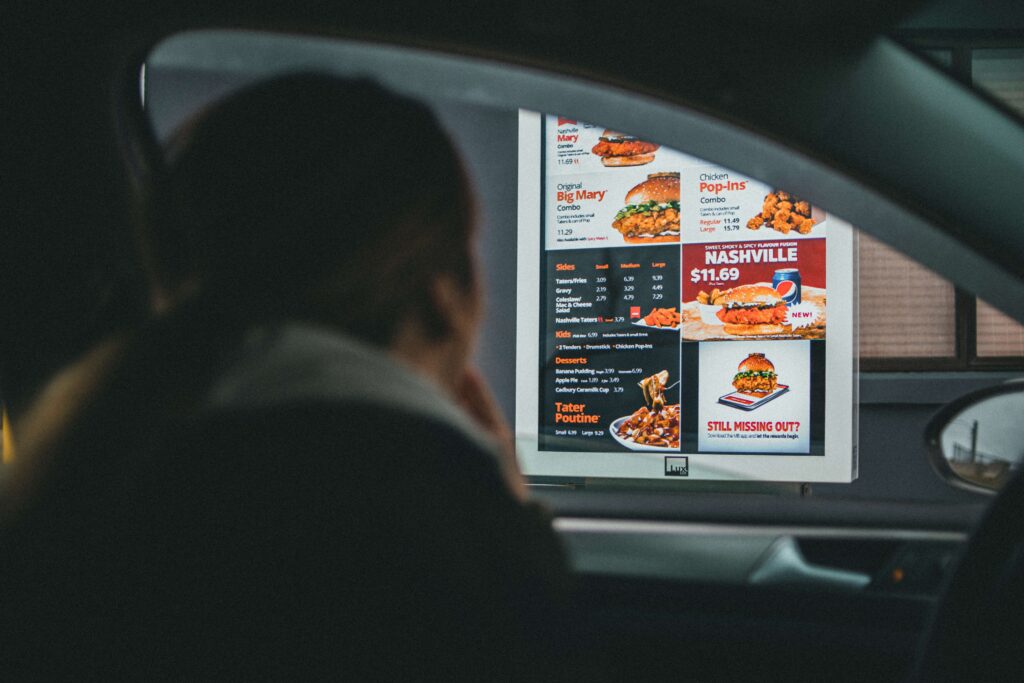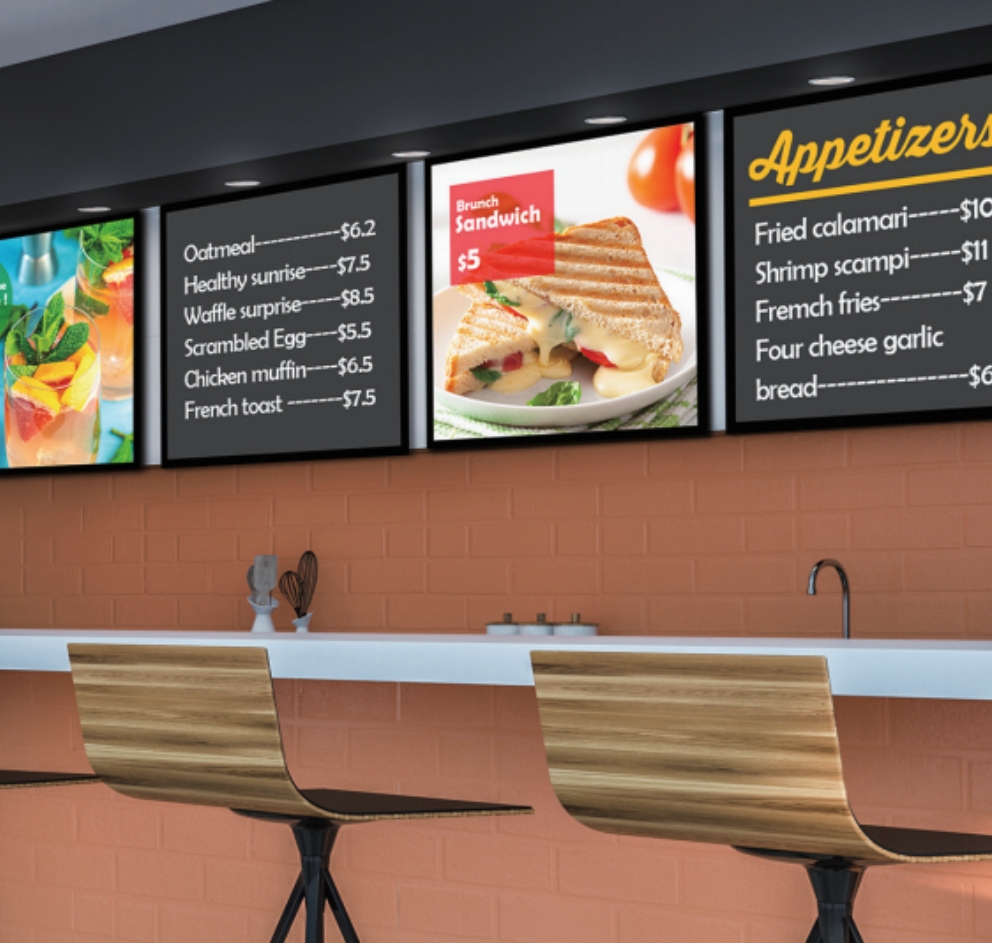Digital Menu Board Budgeting: What Influences Menu Board Prices
Digital menu boards are a must-have for restaurants and food-related multi-location businesses. They offer real-time control over messaging for improved operational efficiency.
These digital displays are precious for retail and hospitality businesses, making updating menu items, promotions, and pricing easy across all locations while enhancing the customer experience.

However, budgeting for digital menu boards is vital to ensure a smooth implementation process and to maximize ROI. Our guide will walk you through the factors influencing menu board prices and help you make an informed decision for your business.
Assessing Your Digital Menu Board Budget Needs
Before diving into the digital menu board budget process, assessing your specific digital menu board needs is essential. This will ensure you make informed decisions and optimize your investment. Here are the key steps to consider:
- Analyzing the locations: Start by evaluating the number of sites requiring digital menu boards. This will help you estimate the overall scale of your project and identify any potential challenges, such as varying store layouts or regional differences in menu offerings.
- Determining the number of digital menu boards required per location: Each location might have different needs regarding the number of menu boards. Consider factors such as store size, customer flow, and the complexity of the menu to determine the ideal number of digital menu boards for each location.
- Choosing the types of digital menu boards: There are various types of digital menu boards available, such as wall-mounted, free-standing, and outdoor displays. Evaluate the specific requirements of each location and choose the most suitable option. For instance, wall-mounted displays might be ideal for smaller spaces. At the same time, free-standing boards can provide more flexibility in terms of placement.
- Determining the installation cost: The installation cost of digital menu boards can vary depending on factors like the complexity of the setup and the need for additional infrastructure. It’s essential to account for these costs in your budget to ensure a seamless implementation process. Reach out to vendors for quotes and consider any potential discounts for multi-location installations.
Operational Benefits of Digital Menu Boards
Digital menu boards offer many operational benefits that can significantly impact your business’s efficiency and customer experience. One advantage is displaying rotational menus, such as daily specials or limited-time offers. This keeps your digital signage menu fresh and engaging and allows you to showcase seasonal items or cater to specific dietary preferences.
Another major benefit is the automation of menu changes based on regional preferences or different times of the day. With digital menu boards, you can easily switch between breakfast and dinner menus or adapt your offerings to suit customers’ tastes in different regions. This ensures that your offerings are always relevant and appealing to your customers.
Additional benefits of digital menu boards include the following:
- Quick pricing updates in response to fluctuations in commodity pricing
- Reduced labor costs due to the automation of menu updates and pricing changes
- Minimized risk of human error
- More efficient allocation of staff to critical tasks like customer service
Finally, digital menu boards are vital in improving the customer experience. They provide a visually appealing and engaging way to present your menu offerings, leading to an enhanced customer experience. Additionally, the ability to display allergen information, nutritional facts, and other relevant details can help customers make informed decisions, resulting in increased satisfaction.
Budgeting for Signage Maintenance

Proper maintenance and upkeep of your digital menu boards are essential for ensuring their longevity and optimal performance. As you budget for signage maintenance, it’s necessary to consider the tasks involved and whether you’ll handle them in-house or outsource them to a professional service provider. Here’s a closer look at the factors to consider for the maintenance portion of your digital menu board budget:
1. Maintenance and Upkeep Tasks
Some everyday maintenance tasks for digital menu boards include:
- Cleaning screens and enclosures to maintain visibility and prevent dust buildup
- Inspecting and replacing damaged or malfunctioning components
- Updating software and firmware to ensure optimal performance and security
- Troubleshooting and resolving technical issues as they arise
2. In-House vs. Outsourced Maintenance
When evaluating the maintenance cost, you must decide whether to handle these tasks in-house or outsource them. Each approach has advantages and drawbacks:
- In-house maintenance can provide more control over the process. It may be more cost-effective if your staff already possesses the necessary skills. However, it could also result in additional training costs and may not be as efficient as outsourcing.
- Outsourcing maintenance to a professional service provider can offer access to specialized expertise. ComQi offers ongoing network health maintenance to ensure optimal performance and minimize disruptions to your operations. This can provide peace of mind and allow you to focus on running your business while leaving the technical maintenance to the digital signage experts.
3. Estimating Maintenance Costs
To budget for digital signage maintenance, consider the following:
- Labor costs: Calculate the cost of staff time for in-house maintenance or the fees charged by an outsourced provider.
- Replacement parts and equipment: Estimate the expenses for any necessary replacement components or tools for maintenance tasks.
- Software updates and support: Factor in costs for software updates and any technical support required.
- Training expenses: If handling maintenance in-house, account for any training costs to ensure your staff can effectively perform the necessary tasks.
Budgeting for Content Creation
Creating visually captivating and appealing content is crucial to attracting customers and increasing sales with digital menu boards. This requires careful budgeting for content creation, including analyzing the specific types of content needed and determining the most cost-effective approach, whether it’s in-house or outsourced.
To start, identify the types of content you’ll need:
- Menu items with descriptions, prices, and images
- Promotions and specials
- Seasonal menus tailored to specific seasons, holidays, or events
- Branding elements like logos, color schemes, and typography
Next, determine what content management system you will use to manage content across your enterprise. A scalable, all in one tool like ComQi’s CMS, EnGage is a reliable option for menu board signage. The tool empowers local staff to drive hyper-localized content and can control thousands of remote players from a central location.
Finally, to determine the cost of content creation, consider labor expenses, estimating the time and wages for in-house content creation or fees charged by an outsourced provider. Additionally, account for equipment and software costs, including any necessary hardware, software, or tools for content creation. Remember to factor in training costs for your staff if you decide to create content in-house.
Digital Menu Board Prices: Calculating Return on Investment (ROI)
Now that we’ve covered what to consider in a digital menu board budget, let’s discuss ROI. Investing in digital menu boards can yield impressive restaurant returns, especially when considering long-term ROI. To understand the potential financial impact of implementing digital menu boards, consider the following statistics:
- 82% of restaurant business owners who use digital signage for displaying product information reported increased sales and 77% experienced better customer satisfaction.
- QMS’s neuroscience study reveals a 24% increase in long-term memory encoding with digital street furniture, showcasing the potential impact of digital signage on brand recall and consumer engagement.
- Digital self-service kiosks at BurgerFi increased average order size by 18.5%, with 52% of customers opting into upsells. The kiosks also accounted for 75% of total orders and 78% of net sales, making them a valuable addition to any restaurant’s digital signage strategy.
- The 14% growth in DOOH reported by OAAA indicates a growing interest in digital signage, including digital menu boards, as an effective advertising medium.
- Digital menus accessed through QR codes have been found to increase the average order value of restaurants by as much as 22%. By integrating QR codes into digital signage displays, restaurants and other businesses can offer an interactive experience for customers and leverage digital signage to improve the customer experience and increase sales.
As you can see, incorporating digital menu boards into your multi-location business can lead to significant benefits, including increased sales, improved customer experience, and streamlined operations. These should all be considered as you create a digital menu board budget. Now, let’s dive deeper into the long-term ROI for digital menu boards at restaurant locations:
- Reduced labor costs: Digital menu boards can automate menu updates, reducing the need for manual intervention and lowering labor expenses.
- Operational efficiency: Digital menu boards enable quick adjustments to menu items, prices, and promotions in response to fluctuations in ingredient costs or market trends, leading to optimized profitability.
- Enhanced customer experience: Digital menu boards can display visually engaging content, which can boost customer satisfaction, increase average order values, and encourage repeat visits.
- Targeted marketing: Digital signage allows location-specific promotions and menu offerings, enabling you to tailor marketing efforts to each restaurant location for improved results.
- Eco-friendliness: Digital menu boards eliminate the need for printed materials, reducing waste and contributing to a greener image that can attract eco-conscious consumers.
Digital Menu Board Price FAQs
Digital menu board costs can vary widely depending on the number of screens, type of hardware, installation expenses, and software requirements. Most menu boards require an array of screens, not just one. The 1×2, 1X3, and 1X4 are the most common screens. A board with 1 row and 2 screens (1X2), for instance, may cost around $2,000 while a menu with 1 row and 4 screens (1×4), can cost $5,000. Remember that this is a rough estimate, and expenses can fluctuate based on your needs.
Yes, you can customize digital menu boards for each location. One of the significant advantages of digital menu boards is their flexibility. In fact, with ComQi’s easy-to-use EnGage platform, you can easily tailor the content displayed on the screens to suit the unique needs of each restaurant location, including specific menu items, pricing, promotions, and regional preferences.
The frequency of digital menu board maintenance depends on the specific hardware and software used. Generally, it’s a good idea to perform regular checkups and updates to ensure optimal performance. This might include cleaning the screens, inspecting the hardware for wear and tear, and updating the software to the latest version. Scheduling maintenance every 3-6 months is a reasonable guideline, but consult your digital signage provider for their recommended maintenance schedule.
The time required to implement digital menu boards across multiple locations depends on various factors, such as the number of sites, the complexity of the installations, and the availability of necessary resources. Typically, completing a rollout across numerous locations can take weeks to months. Communication with your digital signage provider and thorough planning can help streamline the process and minimize disruptions to your operations.
Elevate Guest Experience With ComQi Digital Restaurant Signage
A digital menu board budget is vital for any multi-location business that aims to provide a seamless and engaging dining experience. Digital menu boards can help enhance your restaurant’s atmosphere, streamline operations, and quickly adapt to changing customer preferences. Therefore, budgeting for digital menu boards is crucial for your business strategy.
ComQi offers comprehensive digital signage solutions for restaurants that cater to your unique requirements. With ComQi, you get:
- Tailored menu board designs to match your brand’s aesthetic
- Easy-to-use content management system, EnGage, for real-time control over digital messaging
- Customizable solutions for each of your restaurant locations
- Complete support from conception to installation, ensuring a seamless experience
Ready to elevate your guest experience and enhance your restaurant’s visual appeal? Connect with us and discover how our digital signage solutions can transform your restaurant operations today!
